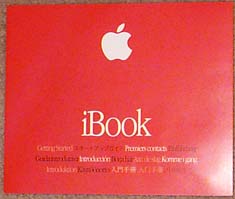



|
|
|
|
The iBook box is quite small, even compared to a PowerBook G3 box. The iBook, complete with charged battery, is padded in a custom foam cocoon. Everything else is in the cardboard Accessory Kit box. |
John Qwerty (something like that) had already written a review of the iBook from the Industry Standard point of view -- without ever even touching one. He pronounced the iBook "girly," something that a Real Man would never consider. What brawny bruiser of the electronic world -- strapped to a high-spirited office chair in an air-conditioned office -- what would such a Real Man want with something out of a Barbie makeup kit? Would a Real Man want something that looked like an oversized woman's compact, in blue or orange? Qwerty had thoroughly covered the Industry Standard point of view, so there was no need to even comment. We were going for the user's point of view.
 |
|
The bright red cover of the Getting Started brochure is printed in English, Japanese, Frehch, German, Italian, and eight other languages. |
|
|
|
Inside the Getting Started brochure, you see four color pictures; there are no words. |
What does the iBook offer? We took a sampling of iBooks (a small sample of one blueberry model) and discovered, fresh out of the box, it came with the following:
|
|
|
Like the Getting Started brochure, the User's Guide has a bright red cover printed in thirteen languages. Inside, however, the text and photo captions are all in English. |
|
|
|
The User Guide is richly illustrated, with color pictures. Though fairly slim, it is one of the most attractive pieces of documentation from Apple in a long time. |
Additionally, the following software was included:
We decided to write the review in AppleWorks for two reasons: first, it was pre-installed on the iBook, and seemed a good way to test how most people would use the machine. Second, we were under severe time constraints. Severe. Time. Constraints.
Opening the box is even easier than opening an iMac box, since it is smaller. A penknife is handy for slicing sealing tape for both the outer box and an inner Accessory Kit box. The iBook comes with many pieces of paper (warranties, packing lists and such), two of which are useful: a fold-out sheet showing in four pictures -- no words -- how to set up the iBook, and a very attractive (complete with color pictures), very short User's Guide. At 32 pages, the User's Guide is brief enough and attractive enough that everyone should read it, right up to and including the five pages of material under "Where's the fine print?" The detailed instructions on how to dial telephone numbers with the modem in New Zealand are hilarious:
[...]
* Number to be dialed: 1; number to be entered into computer: 9
* Number to be dialed: 2; number to be entered into computer: 8
* Number to be dialed: 3; number to be entered into computer: 7
[...]
"You have one hour." One hour!?!?!
Following the step-by-step instructions (actually, we read them after the fact), we opened the box, took the plastic off the iBook, opened the top, and pressed the Power On key. Thanks to the fact that the iBook shipped with a charged battery, we were immediately off and running. Within seconds, we noticed two things we really wanted:
Other things we thought we'd mind, but didn't:
Because of severe time constraints, we didn't try out the built-in modem. Others claim it works, and we're willing to take their word for it. Instead, we plugged a 10BASE-T cable into the 10/100 BASE-T Ethernet jack (conveniently located on the left side; there are no jacks on the back of the computer). With a few deft entries into the TCP/IP Control Panel, we were configured for the Internet and off and running.
Revised November 24, 1999 Lawrence I. Charters
Washington Apple Pi
URL: http://www.wap.org/journal/